Embarking on the verdant landscapes of the Philippines, where the tropical allure meets agricultural innovation, we delve into the realm of pineapple farming. In this exploration, we unravel the diverse varieties of pineapples cultivated in the archipelago, each boasting unique flavors and characteristics. Beyond the lush fields, we transition to meticulous economic analysis, deciphering the financial landscape of this agricultural venture.
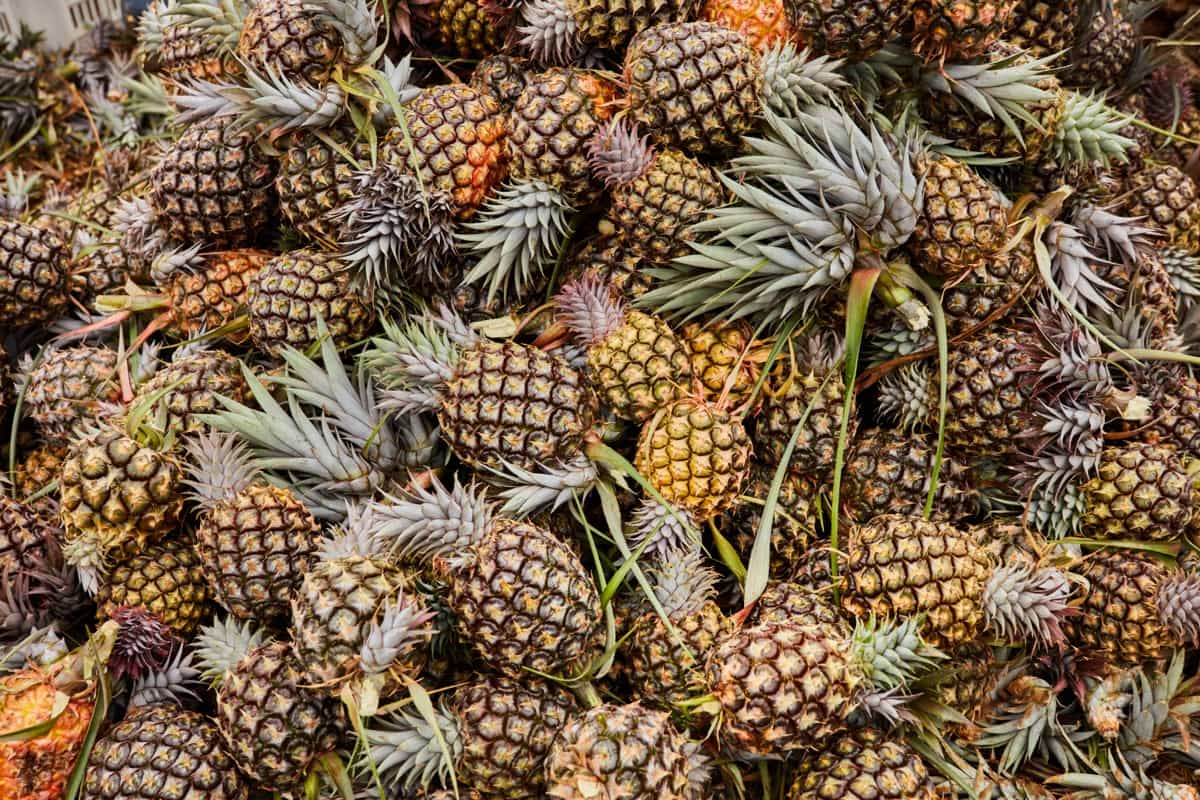
Pineapple Farming in the Philippines
What is Pineapple Farming in the Philippines?
Pineapple farming is the cultivation of pineapple plants for their fruits, which are used for various purposes such as fresh consumption, processing, and export. Pineapple is a tropical fruit belong Bromeliaceae family. It has a cylindrical shape with a crown of spiny leaves and a yellow, juicy flesh with a sweet and sour taste. Pineapple is rich in vitamin C, bromelain, fiber, and antioxidants, which provide various health benefits.
Pineapple farming role in the Philippine agricultural industry. The country is one of the top producers of pineapples and globally, with an annual production output up to 2.5 million metric tons. Pineapple farming contributes to the food security, income generation, and employment opportunities of many Filipino farmers, especially in rural areas.
Climate and Soil Requirements for Pineapple Farming
Pineapple thrives over a wide range of soils and climatic conditions. Still, the plant grows best at elevations of 150 to 240 meters above sea level with a temperature of 24-30 degrees Celsius that should be relatively uniform throughout the year. Rainfall should be between 100 to 150 centimeters per year and evenly distributed during the growing period; it is considered best for maximum yield. Soil should be well-drained with a pH of 4.5 to 5.5.
Varieties of Pineapple Grown in the Philippines
Several varieties of pineapple are available in the Philippines. The Smooth Cayenne or Hawaiian is the largest, most common, and best for canning type. The Queen, also known as the African Queen or Formosa, is the nicest. The Native Philippine Red, also called the Red Spanish, is shaped like a cone and is thought to be of average quality. It is also grown for its fiber. The Cabezona is the largest, measuring approximately 8-12 inches long when fully matured. Other varieties include the Buitenzong or Java, Sugar Loaf, and Abakka.
In case you missed it: Beekeeping in the Philippines: Exploring Apiculture Industry in the Philippines
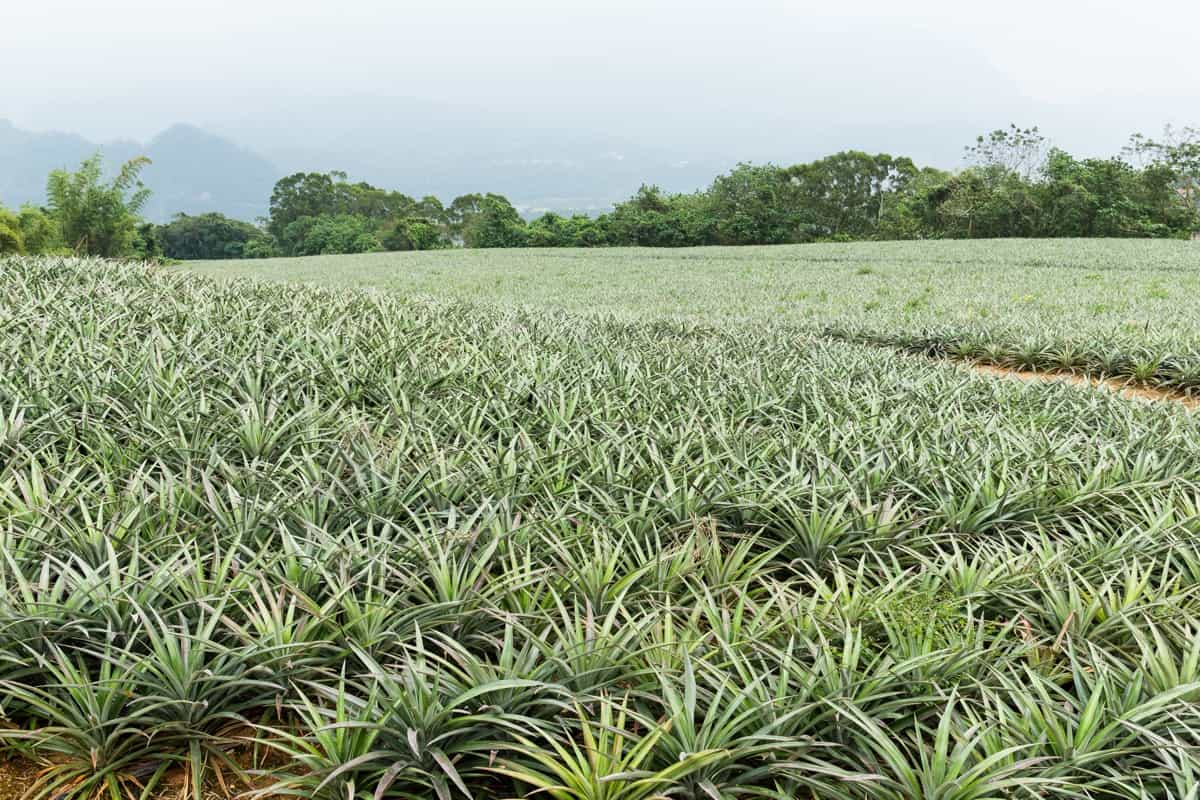
Propagation Methods for Pineapple Farming
Pineapple plants can be propagated using different methods, such as seeds, suckers, slips, crowns, or stem cuttings. However, seeds are rarely used because they produce variable offspring and take longer to mature. The most common method of propagation is using suckers, which are mostly shoots that grow from the base of mature plants. Suckers are preferred because they produce uniform plants that bear fruits earlier than other methods.
Land Preparation for Pineapple Plantation
- Clearing the land of brush and weeds.
- Plowing and harrowing the field two to three times.
- Applying organic matter such as compost, manure.
- Making furrows or beds according to the planting distance.
The recommended planting distance varies depending on the variety and plant density. For example, Smooth Cayenne can be planted at 30 x 30 cm with a plant density of 111,111 plants per hectare, while Queen can be planted at 25 x 25 cm with a plant density of 160,000 plants per hectare.
Planting Techniques for Pineapple Farming
Planting techniques for pineapple farming depend on the type of propagules used. For suckers, slips, crowns, or stem cuttings, they should be planted upright or slightly inclined in the furrows or beds, with the base covered with soil. The propagules should be healthy, disease-free, and uniform in size and shape. The best time to plant is during the rainy season, from June to August.
Irrigation and Water Management in Pineapple Farms
Pineapple plants require adequate water for optimum growth and fruit development. However, they are also sensitive to waterlogging and drought stress, which can affect their yield and quality. Therefore, irrigation and water management in pineapple farms should be done carefully and efficiently.
In case you missed it: Sorghum Farming in the Philippines: A Step-by-Step Production Guide
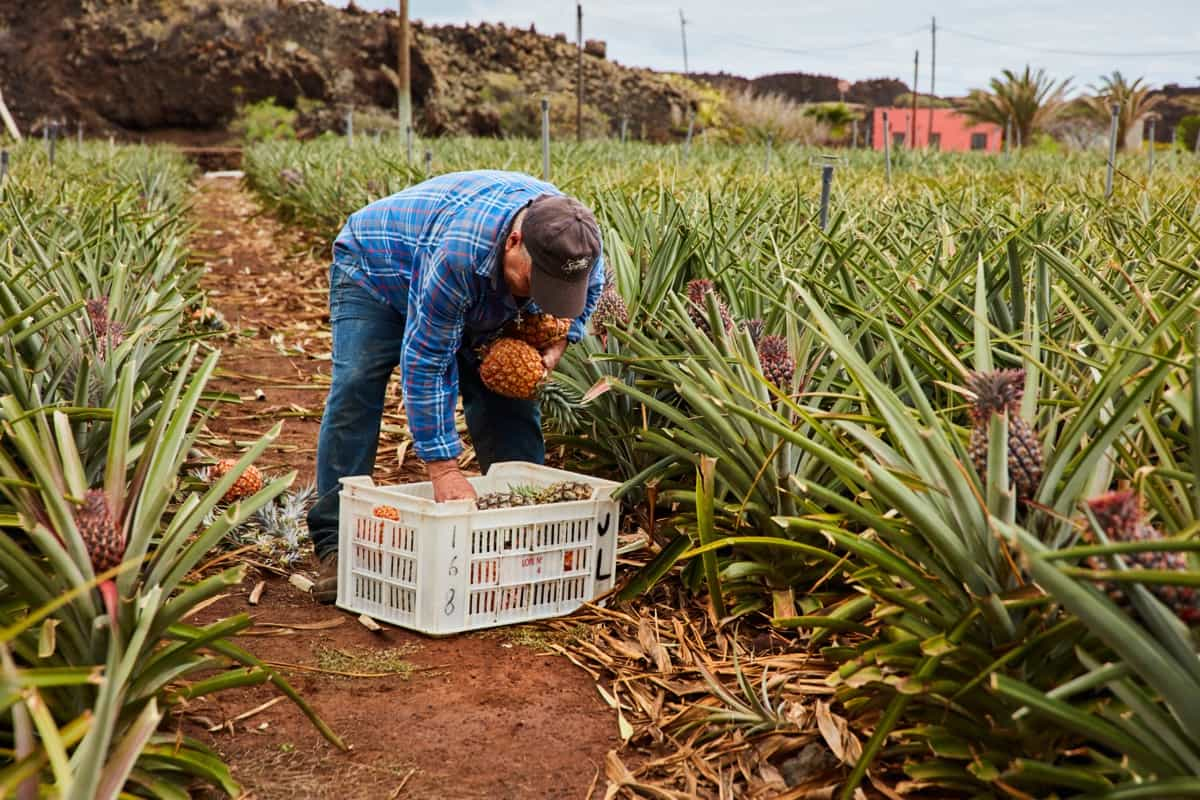
The frequency and amount of irrigation based on the soil type, rainfall, temperature, and plant growth stage. Generally, pineapple plants need more water during the first six months of growth and less water during the fruiting stage. Drip irrigation is recommended as it saves water and reduces weed growth.
Fertilizer Application in Pineapple Cultivation
Fertilizer application in pineapple cultivation is essential to provide the necessary nutrients for the plants and enhance their yield and quality. Pineapple plants need nitrogen, phosphorus, potassium, calcium, magnesium, sulfur, and micronutrients like iron, manganese, zinc, copper, boron, and molybdenum.
The amount and type of fertilizer depend on the soil fertility, variety, plant density, and growth stage. Generally, pineapple plants need more nitrogen and potassium during the vegetative stage and more phosphorus and calcium during the fruiting stage. Fertilizers can be applied in split doses through broadcasting or banding along the furrows or beds.
Pest and Disease Management in Pineapple Farms
Pest and disease management in pineapple farms is important to prevent losses and maintain the quality of the fruits. Pineapple plants are susceptible to pests, diseases, such as mealybugs, scales, mites, nematodes, ants, rats, birds, bats, fungal infections, bacterial infections, viral infections, and nutritional disorders.
The best way to control pests and diseases is through integrated pest management (IPM), which involves cultural practices, biological control agents, physical barriers, mechanical methods, and chemical pesticides. IPM aims to reduce the use of pesticides and minimize their negative impacts.
Weed Control Strategies for Pineapple Plantations
Weed control strategies for pineapple plantations are necessary to reduce competition for water, nutrients, light, and space. Weeds can also act as host to pests and diseases that can affect the pineapple plants. Weed control can be done manually, weeding, or mechanically by using tools such as hoes or cultivators. However, these methods are labor-intensive and time-consuming.
Alternatively, weed control can be done chemically by using herbicides that are selective for pineapple plants. However, these chemicals should be used with caution as they can harm the environment and human health if not applied properly.
Harvesting and Post-Harvest Practices in Pineapple Farming
Harvesting and post-harvest practices in pineapple farming ensure the quality and shelf life of the fruits. Pineapple fruits are ready for harvest when they reach maturity, which can be determined by various indicators such as color change, size, weight, sugar content, acidity level, aroma, or sound when tapped. The maturity stage depends on the variety and market preference.
For example, Smooth Cayenne is harvested at 75-80% color change for fresh consumption or 10-15% color change for processing. Queen is harvested at 50-60% color change for fresh consumption or 20-30% color change for processing. Harvesting should be done to avoid damaging the fruits or injuring the workers. The fruits should be cut with a sharp knife or a sickle at the base of the peduncle or stalk. The fruits should be handled gently and placed in clean containers or baskets lined with soft materials such as banana leaves or newspapers.
The fruits should be sorted according to size, shape, color, weight, and quality. The fruits should be cleaned with water to remove dirt and debris. The fruits should be treated with fungicides and wax to prevent fungal infections or moisture loss. The fruits should be stored in cool and dry places with good ventilation. The fruits should be transported in well-ventilated vehicles with cushioning materials to avoid bruising or crushing.
In case you missed it: How to Start Organic Farming in the Philippines: Schemes, Certification, Profits, Cost, and Challenges
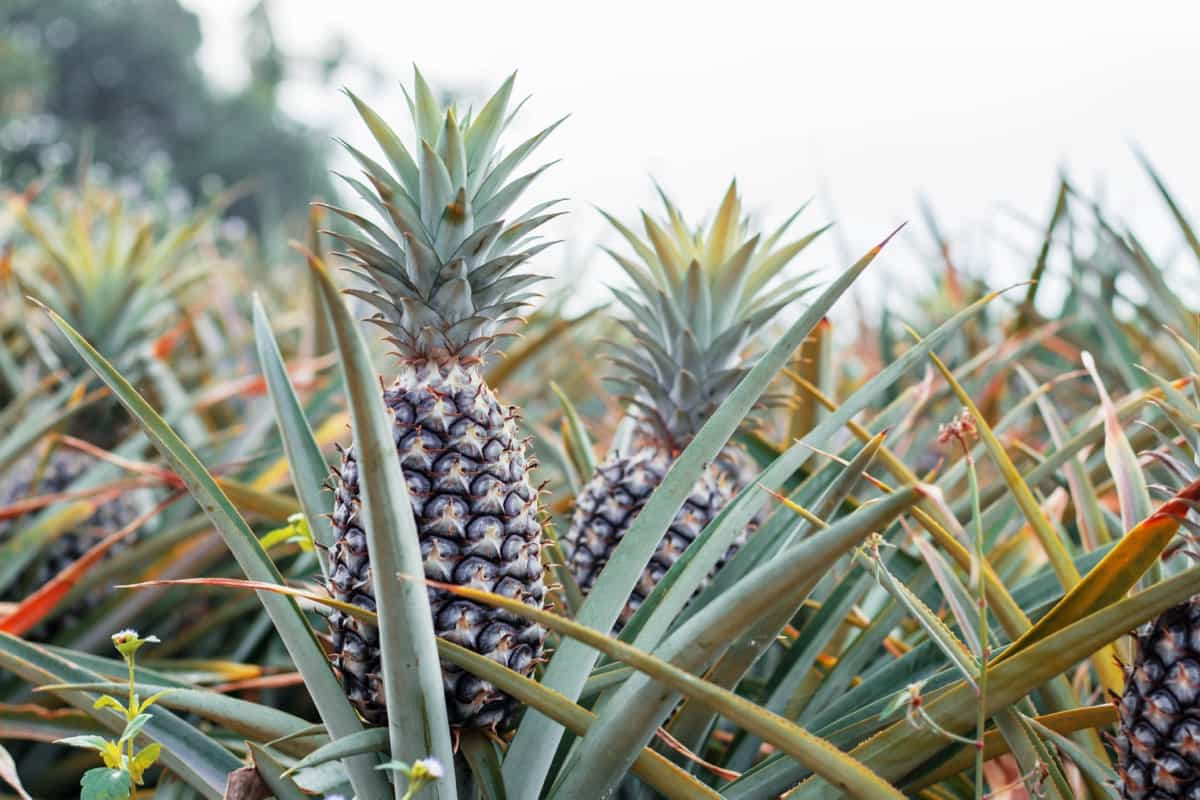
Marketing and Value Chain of Philippine Pineapples
Pineapple, a crucial tropical fruit globally, is produced in the Philippines, which is the second-largest producer after Costa Rica. The industry involves various actors along the value chain, from production to consumption. Producers, farmers responsible for land preparation, planting, fertilization, pest and disease management, harvesting, and post-harvest handling, sell their pineapple to traders, processors, or exporters. Traders are intermediaries who buy pineapple from producers and sell it to processors, exporters, wholesalers, retailers, and consumers.
Processors transform fresh pineapple into various products, adding value through processing, packaging, and branding. Exporters export pineapple products to foreign markets, complying with importing countries’ quality standards. Wholesalers distribute pineapple products to retailers or institutional buyers, providing transportation, storage, and marketing services.
Retailers sell pineapple products to final consumers, such as supermarkets, grocery stores, and convenience stores, displaying and promoting them to attract customers. Consumers choose among different brands, varieties, and qualities of products based on their preferences, income, and availability. A value chain analysis of pineapple in the Philippines reveals different levels of value addition and profitability among these actors.
The percentage of market margin for producer, assembler, wholesaler, retailer, and processor actors was 9.41%, 11.86%, 18.33%, 26.96%, and 33.43%, respectively. The producer’s share of the final consumer price was only 34.20%, while the processor’s share was 18.33%. This indicates a high degree of market concentration and power among downstream actors, particularly processors and retailers.
Economic Analysis of Pineapple Farming in the Philippines
The economic analysis of pineapple farming in the Philippines shows that it is a profitable venture for most farmers. The average cost of production per hectare of pineapple was 163,875 pesos ($3,277), while the average gross income was 282,000 pesos ($5,640). Average net income of 118,125 pesos ($2,363) per hectare per year. The average return on investment (ROI) was 72%, which means that for every peso invested in pineapple farming, there was a return of 1.72 pesos.
Pineapple farming faces several challenges and risks that impact its profitability and sustainability. Climate change, pest and disease outbreaks, high input costs, low bargaining power, limited access to credit, and lack of market information are some of the challenges faced by pineapple farmers. Climate change can cause crops and reduce yields, while pests, diseases can affect plant health and productivity.
High input costs can increase production costs and reduce profits. The small-scale nature of pineapple farmers makes them vulnerable to exploitation by traders and processors. Limited access to credit from formal sources can hinder farmers from investing in improved technologies and practices. Additionally, the lack of market information can prevent farmers from making informed decisions and capturing better opportunities.
In case you missed it: How to Start a Crab Farming in the Philippines: Business Plan, Types of Crabs, Indoor and Cage Culture
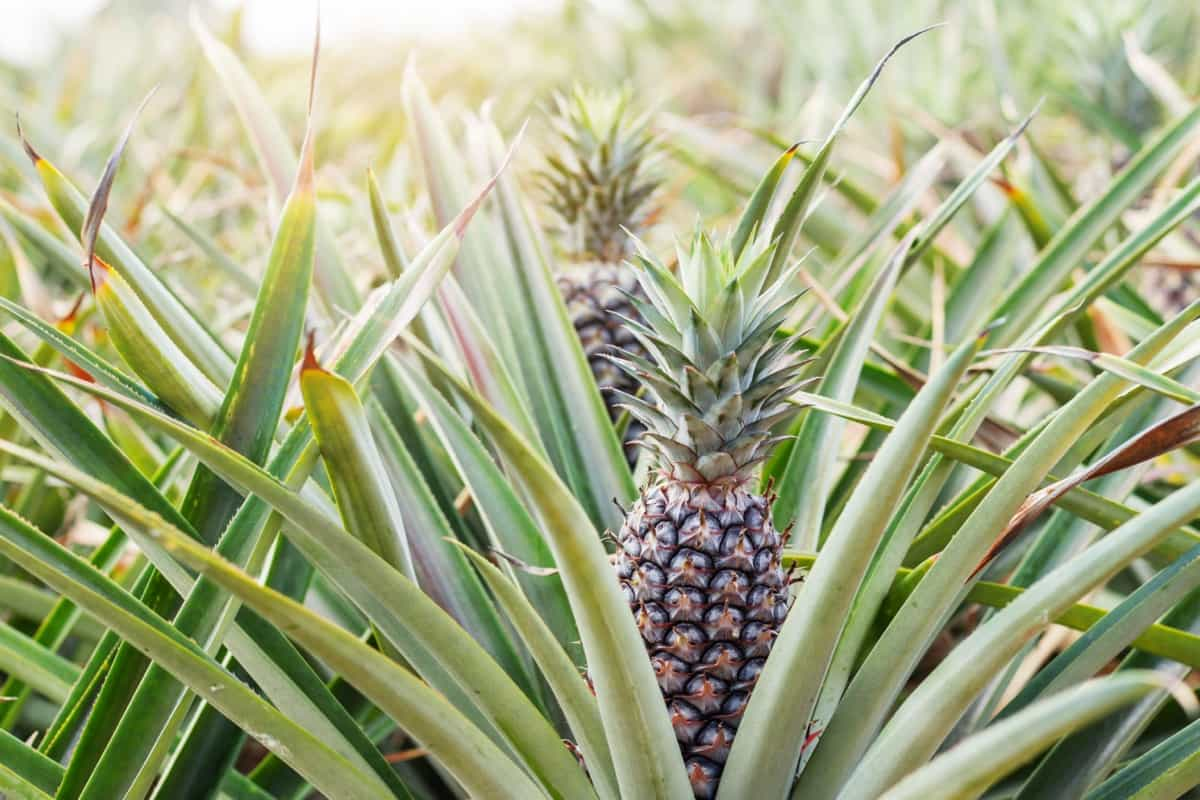
Government Support and Programs for Pineapple Farmers
The Philippine government has implemented several support programs and initiatives to help pineapple farmers improve their competitiveness and address challenges. These include the Philippine Rural Development Project (PRDP), a World Bank-funded initiative that improves rural infrastructure, market access, and enterprise development of agricultural commodities, including pineapple. The High-Value Crops Development Program (HVCDP) promotes the production, processing, and marketing of high-value crops like pineapple, offering support services such as seedlings, fertilizers, pesticides, farm equipment, training, and extension.
The Agricultural Credit Policy Council (ACPC) facilitates access to credit for small farmers and fisherfolk through various credit programs. The Philippine Crop Insurance Corporation provides insurance coverage to farmers from losses due to natural calamities, pest and disease infestations, and other perils. The Bureau of Agricultural Research (BAR) conducts research and development activities on various agricultural commodities, including pineapple, to improve productivity, profitability, and sustainability.
The pineapple industry in the Philippines is a vital sector contributing to the country’s economy, food security, and rural development. However, it faces challenges that need to be addressed by stakeholders along the value chain. By enhancing the value addition, profitability, and competitiveness of each actor, the industry can reach its full potential and benefit more people.
In case you missed it: How to Start Rabbit Farming in the Philippines: Business Plan, Profit, Subsidy, Loans, and Requirements
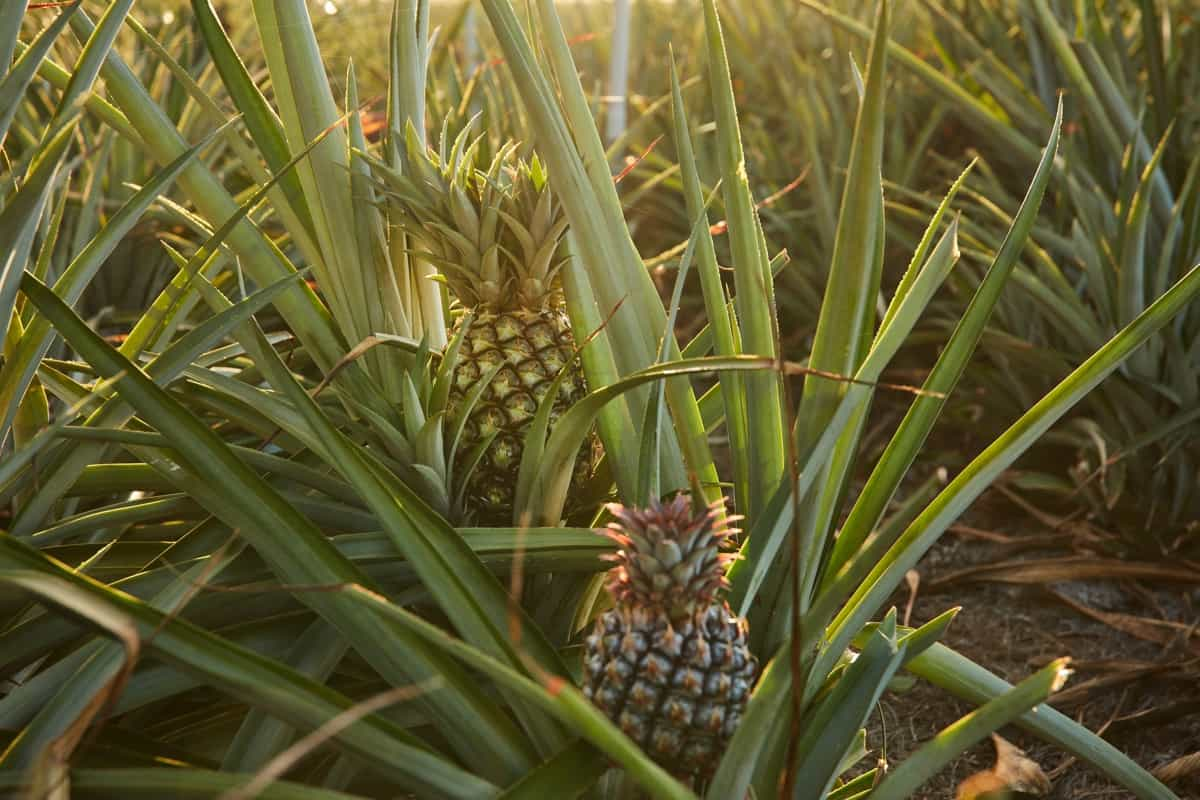
Conclusion
The exploration of pineapple farming in the Philippines and the intricate tapestry of diverse varieties intertwine with a thorough economic analysis. This symbiotic relationship reveals not only a flavorful journey through unique pineapple strains but also a financially viable agricultural landscape, ensuring sustainable growth and prosperity for the Philippine pineapple industry.
- Types of Pesticides Used in Agriculture: A Beginner’s Guide
- Economical Aquaculture: A Guide to Low-Budget Fish Farming
- 15 Common Planting Errors That Can Doom Your Fruit Trees
- How to Make Houseplants Bushy: Effective Tips and Ideas
- Innovative Strategies for Boosting Coconut Pollination and Yield
- Pollination Strategies for Maximum Pumpkin Yield
- The Complete Guide to Chicken Fattening: Strategies for Maximum Growth
- Natural Solutions for Tulip Problems: 100% Effective Remedies for Leaf and Bulb-Related Issues
- Revolutionizing Citrus Preservation: Towards a Healthier, Greener Future
- Natural Solutions for Peony Leaf and Flower Problems: 100% Effective Remedies
- Maximizing Profits with Avocado Contract Farming in India: A Comprehensive Guide
- Natural Solutions for Hydrangea Problems: 100% Effective Remedies for Leaf and Flowers
- The Ultimate Guide to Choosing the Perfect Foliage Friend: Bringing Life Indoors
- From Sunlight to Sustainability: 15 Ways to Use Solar Technology in Agriculture
- The Ultimate Guide to Dong Tao Chicken: Exploring from History to Raising
- The Eco-Friendly Makeover: How to Convert Your Unused Swimming Pool into a Fish Pond
- Mastering the Art of Delaware Chicken Farming: Essentials for Healthy Backyard Flocks
- 20 Best Homemade Fertilizers for Money Plant: DIY Recipes and Application Methods
- How to Craft a Comprehensive Free-Range Chicken Farming Business Plan
- Brighten Your Flock: Raising Easter Egger Chickens for Beauty and Bounty
- How to Optimize Your Poultry Egg Farm Business Plan with These Strategies
- Subsidy for Spirulina Cultivation: How Indian Government Schemes Encouraging Spirulina Farmers
- Ultimate Guide to Raising Dominique Chickens: Breeding, Feeding, Egg-Production, and Care
- Mastering the Art of Raising Jersey Giant Chickens: Care, Feeding, and More
- Ultimate Guide to Raising Legbar Chickens: Breeding, Farming Practices, Diet, Egg-Production
- How to Raise Welsummer Chickens: A Comprehensive Guide for Beginners
- How to Protect Indoor Plants in Winter: A Comprehensive Guide
- Ultimate Guide to Grow Bag Gardening: Tips, Tricks, and Planting Ideas for Urban Gardeners
- Guide to Lotus Cultivation: How to Propagate, Plant, Grow, Care, Cost, and Profit
- Agriculture Drone Subsidy Scheme: Government Kisan Subsidy, License, and How to Apply Online
- Ultimate Guide to Raising Araucana Chickens: Breed Profile, Farming Economics, Diet, and Care
- Bringing Hydroponics to Classroom: Importance, Benefits of Learning for School Students
- Ultimate Guide to Raising Polish Chickens: Breed Profile, Farming Economics, Diet, and Care
- Ultimate Guide to Raising Australorp Chickens: Profile, Farming Economics, Egg Production, Diet, and Care
- Silkie Chicken Farming: Raising Practices, Varieties, Egg Production, Diet, and Care
- Sussex Chicken Farming: Raising Practices, Varieties, Egg Production, Diet and Care